Last Updated on May 20, 2023 by a Friendly Gardener
The popular Maranta leuconeura, called “Prayer plants”, are beloved for their spectacular vividly colored leaves. This species of tropical plant is easy to take care of and adapts beautifully to low-light environments making them ideal for indoor cultivation. Still, like all houseplants they do have issues, with one of the most common being curling leaves. There are several causes for prayer plant leaves curling and we’ve listed them with suggestions about what to do.
An important thing to keep in mind is that all new leaves on a prayer plant will emerge curled. They unfurl when they reach maturity. So, before deciding you have an issue to treat, make sure that the curling leaf is not merely new growth. When mature foliage curls, you’ll need to determine the cause and take action.
Causes of Prayer Plant Curling Leaves and What to Do
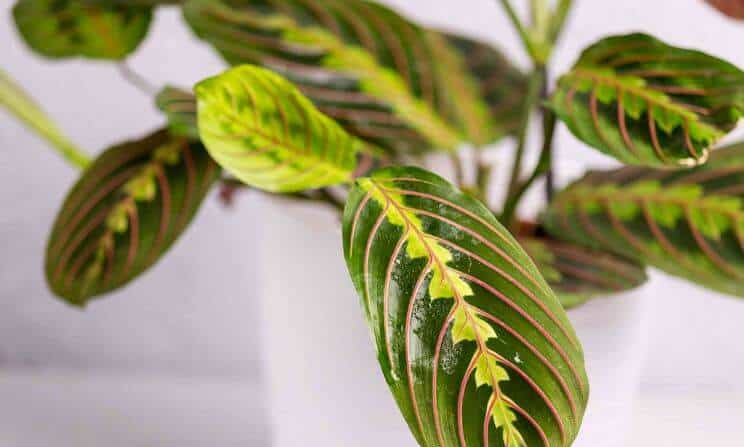
Underwatering the Prayer Plant
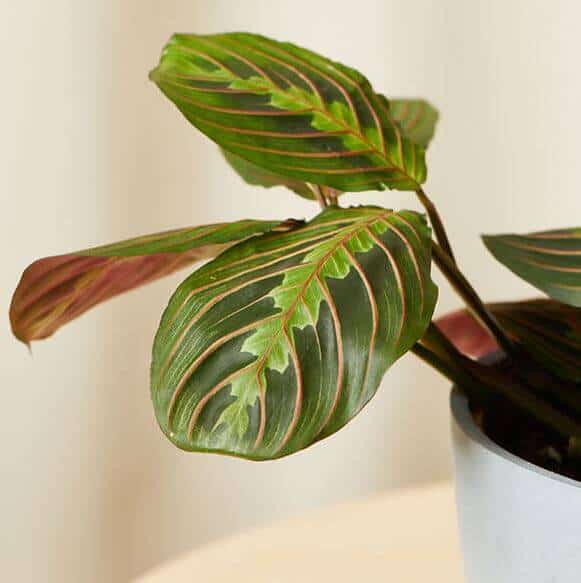
Prayer plants thrive in consistently moist soil. If the soil bed dries too much, the foliage will begin to curl communicating that there is a problem. Curling leaves will most likely also droop, appearing to wilt or go limp. The best remedy is to water your plant thoroughly, perhaps even soaking your plant and then letting excess water drain out completely. Bottom watering is also an option where your plant gradually soaks up the amount of water it needs. You may have to adjust your plant’s watering schedule to avoid repeats. Another symptom of underwatering is brown leaf tips.
If you water your prayer plant and nothing happens within a 24-hour period, your plant may have dried to the point that the root system has died. This explains why no improvement is noted as a dead root ball will no longer be able to absorb water. You can attempt to save it by removing the plant from the soil and placing it in a vase or jar with water in the hopes that new roots will form. If new roots develop, wait several weeks until they are at least an inch in length and transplant your plant in fresh soil.
Prayer plants drink a bit more than other houseplants. If you regularly forget to water your plants or are absent for several days, you may want to try water globes. These are inserted above the soil surface and your prayer plant will extract water as it needs it. They are easy to use as water levels are above the soil, so you know when to refill them. Also, avoid using cold water to prevent shocking your plant. Opt for water at room temperature.
Overwatering a Prayer Plant
Believe it or not, overwatering can also cause leaves to curl. While this plant loves moist soil, it does not do well in soggy soil. Aside from creating a breeding ground for fungus gnats, soggy soil will allow your plant to develop root rot. In soggy soil, roots drown and are unable to take in precious oxygen. Root rot so damages roots that they are unable to absorb and send water to stems and foliage creating a condition where foliage appears underwatered, thus the curling.
Improper Water Quality
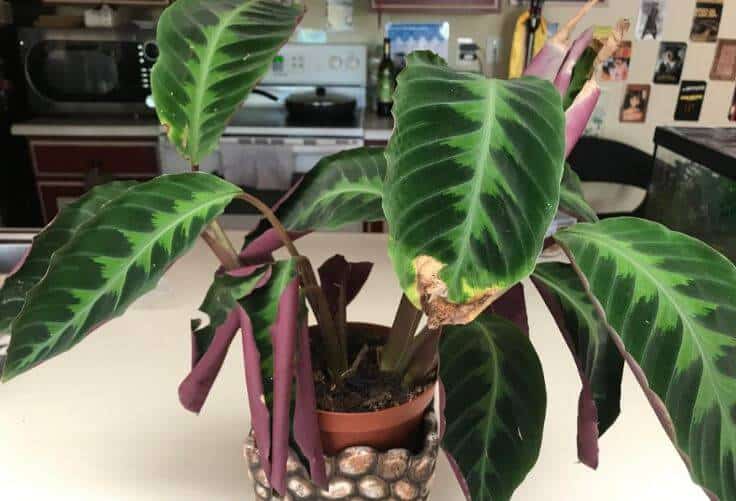
These delicate divas can exhibit sensitivity to the water quality, especially when watering with municipal tap water with minerals and chemical additives. Collected rainwater is the best solution, but distilled or filtered water will work as well.
Inadequate Humidity Levels
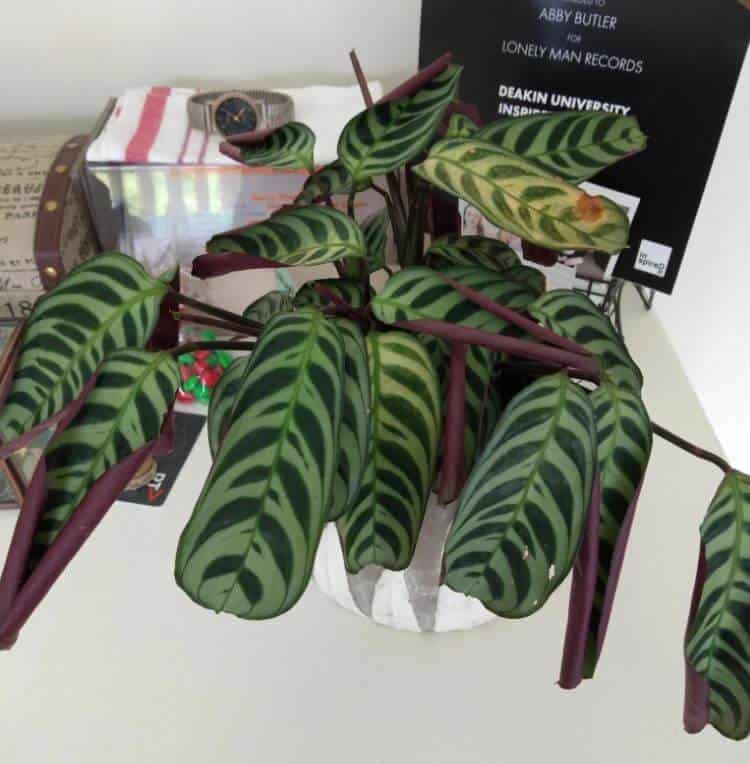
Prayer plants are able to adapt to typical household humidity, but ideal conditions will see humidity levels measuring 50% or above, so check your home humidity just to be sure. If the environmental air is too dry, leaves will curl. Beware of placing your plant too near to a climatization unit that dries out the air in the immediate area. If you find your home humidity is too low, you can do one of several things to protect your plant.
If there is a room with higher humidity such as a bathroom or kitchen, you may want to change your plant’s location. Portable space humidifiers work well and will resolve the issue in the specific area where your plant sits. Pebble trays with water are an easy and quick solution. Fill a tray with pretty pebbles and add water. Place your plant’s container on top. (The bottom of the pot should not come into contact with the water.) This option will also create humidity in the air around your plant. The ray should be refilled periodically as the water will evaporate.
You may also want to group several plants as this will create a microclimate as the plants transpire moisture into the air.
Inadequate Sunlight
The fact that prayer plants can adapt beautifully to low light conditions, does not mean they will grow in the dark. They still require light. In an ideal situation, they should receive moderate, indirect, bright light. In low-light environments, their growth rate will slow. Prayer plant curled leaves may indicate a sunlight exposure problem, especially if you have an appropriate water schedule and humidity level.
In this case, move your plant to a spot with more bright light. These plants should never be exposed to direct sunlight. If you do not have a spot near a window, use a grow light in the vicinity to compensate for lighting needs.
Improper Environmental Temperatures
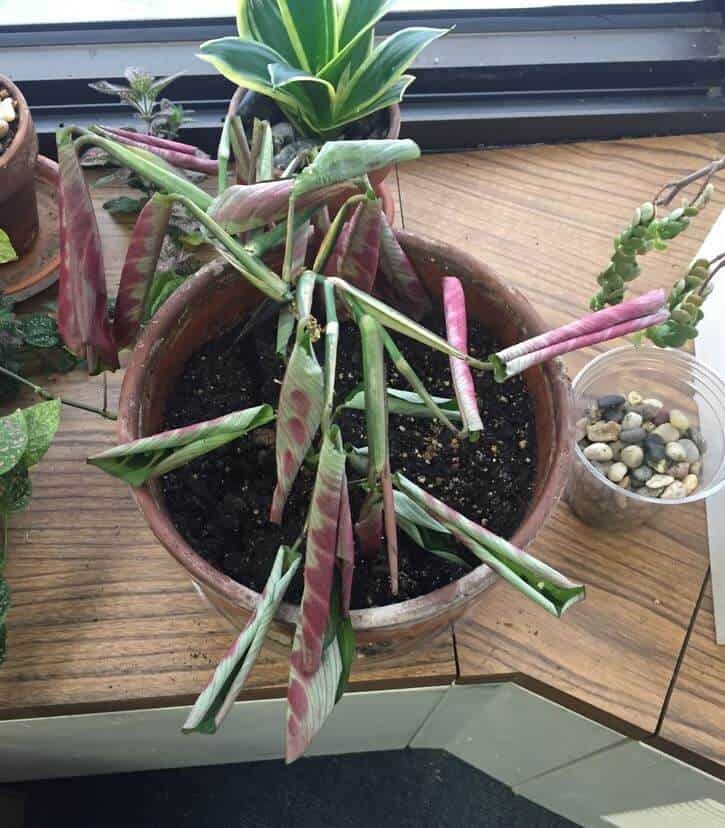
Any exposure to extreme temperatures, whether hot or cold, can provoke a reaction. Prayer plant leaves curled due to non-tropical temperatures are not unheard of. Although this is a rarer cause of curling foliage. The Prayer plant prefers temperatures in the 60° to 80° F. range, which is why they are perfect for indoor cultivation.
Generally, temperature should not be an issue, however, for residents of colder climates with harsh winters, it’s wise to position your prayer plant away from windows and doors to avoid drafts and temperature changes. The same is true for those cultivating in zones with torrid summers. The Prayer plant will suffer when temps surpass 80°F.
Prayer Plants are fascinating plants with vibrant colors and leaves that fold as if in prayer when the sun sets. Keeping your prayer plant healthy will afford you a stunning, living addition to your indoor décor.


